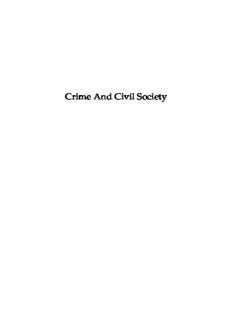
Crime & Civil Society PDF
Preview Crime & Civil Society
Crime And Civil Society Crime And Civil Society Can We Become A More Law-Abiding People? David G. Green Emma Grove Nadia A. Martin Foreword by His Honour Judge Alan Taylor Additional Essay by Norman Dennis Civitas: Institute for the Study of Civil Society London Registered Charity No. 1085494 First published February 2005 © The Institute for the Study of Civil Society 2005 77 Great Peter Street London SW1P 2EZ email: [email protected] All rights reserved ISBN 1-903 386-36 5 Independence: The Institute for the Study of Civil Society (CIVITAS) is a registered educational charity (No. 1085494) and a company limited by guarantee (No. 04023541). CIVITAS is financed from a variety of private sources to avoid over-reliance on any single or small group of donors. All publications are independently refereed. All the Institute’s public- ations seek to further its objective of promoting the advancement of learning. The views expressed are those of the authors, not of the Institute. Typeset by Civitas in Palatino Printed in Great Britain by St Edmundsbury Press Ltd Blenheim Industrial Park, Newmarket Road Bury St Edmunds, Suffolk Contents Page Authors vii Preface David G. Green ix Foreword His Honour Judge Alan Taylor xi Understanding and the Social Sciences Norman Dennis xvii Summary xxxi 1. Introduction 1 2. Rival Explanations of Crime 23 Part I How To Reduce Reoffending: The Evidence 3. Incapacitation and Deterrence 41 4. Rehabilitation 56 5. Prison-Based Therapeutic Communities 79 6. Prison Education and Work 92 7. Intensive Supervision in the Community 104 8. Community-Based Drug Treatment 124 9. Boot Camps and Shock Tactics 145 10. Financial Penalties 157 11. Post-Release Support of Prisoners—Throughcare 170 12. Probation and Restorative Justice 189 Part II Conclusions and Implications for Public Policy 13. Can We Learn From America? 209 14. Guiding Principles for Public Policy 220 15. Government Policy in 2005 240 v vi CRIME AND CIVIL SOCIETY Page Appendix 1 261 Appendix 2 262 Appendix 3 264 Appendix 4 266 Appendix 5 268 Appendix 6 270 Appendix 7 271 List of Abbreviations 273 Bibliography 275 Notes 297 Authors David G. Green is the Director of Civitas. His books include The New Right: The Counter Revolution in Political, Economic and Social Thought, Wheatsheaf, 1987; Reinventing Civil Society, IEA, 1993; Community Without Politics: A Market Approach to Welfare Reform, IEA, 1996; Benefit Dependency: How Welfare Undermines Independence, IEA, 1998; An End to Welfare Rights: The Rediscovery of Independence, 1999; Delay, Denial and Dilution, 1999 (with Laura Casper); Stakeholder Health Insurance, Civitas, 2000; Health Care in France and Germany: Lessons for the UK, Civitas, 2001 (with Ben Irvine). He wrote the chapter on ‘The Neo- Liberal Perspective’ in Blackwell’s The Student’s Companion to Social Policy, (2nd edn) 2003. He writes occasionally for newspapers, including in recent years pieces in the Guardian and The Sunday Times (on health reform), The Times (on race, NHS reform and crime) and the Daily Telegraph (on crime). Emma Grove grew up in London. She was educated at the City of London School for Girls and the University of Edinburgh, graduating with a First in Sociology in 2003. She was a crime researcher at Civitas and is now working at The Times. Nadia A. Martin was raised in Massachusetts where she attended the Groton School. She earned her BSc degree at the Walsh School of Foreign Service at Georgetown University. At Civitas, Nadia has worked on crime, family and healthcare policy. Her previous works include Marriage on MARS, a study of the Government’s support of marriage and family, published by Civitas in 2002. She has appeared as a commentator on the BBC and Sky as well as in newspaper articles. Now based at the Stockholm School of Economics, she is pursuing further studies and research in economics and finance. vii Preface Our aim is to understand how best to encourage a more law-abiding society. The study is organised as follows. The first chapter describes the current crime problem and Chapter 2 goes on to discuss the main standpoints in today’s public debate. Part I, comprising Chapters 3-12, examines the various measures taken to reduce offending, drawing a good deal on North American evidence, where efforts to evaluate programmes have been far more rigorous than here. Policing plays a major role in reducing crime, but is the subject of a separate study by Norman Dennis, Cultures and Crimes: Policing in Four Nations.1 Here we focus on the role of the criminal justice authorities in reducing reoffending by convicted criminals. Part II, comprising Chapters 13-15, focuses on public policy recommendations. Chapter 13 looks at the latest American thinking, Chapter 14 sets out the guiding principles for reform and Chapter 15 appraises the policies of the British Government. The authors are grateful to Rosie Milner, Josie Cluer, James Cave and Ian Ginsberg for their research assistance during their time at Civitas. The study received funding from Reform and from the Esmée Fairbairn Foundation’s Rethinking Crime and Punishment initiative, each allowing a full-time researcher to be employed. David G. Green ix
Description: